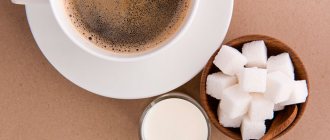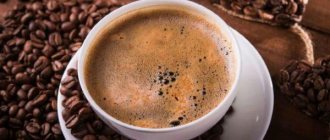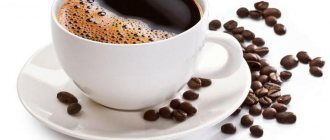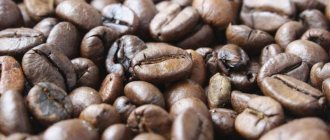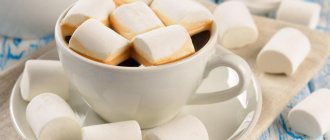Most people drink their coffee sweet. A pure black drink can taste sour (Arabica) or bitter (Robusta), or it can combine both of these shades. Sweeteners are especially often added to instant drinks in order to somehow dampen the chemical taste and make it at least a little tasty. And if coffee itself contains almost no calories, then even a spoonful of granulated sugar significantly increases the calorie content of the drink. But many of us drink not from a small cup, but from a large mug, and put two spoons, and even heaped ones. So how to calculate the calorie content of coffee with sugar, depending on various parameters?
How many calories are in coffee with sugar?
There is no definite answer to this question and there cannot be. Everything varies depending on the volume of the cup, the amount of dry matter, and especially the sweetener, as well as the method of preparation. But you can roughly calculate the number depending on how much and what kind of sugar you add, since the calorie content of the finished drink will depend entirely on the amount of sugar. At the same time, we assume that there are no more additives in the coffee.
Loose sugar
One standard size teaspoon holds:
- 5 g without slide;
- 7 g with a small slide;
- 10 g with a large slide.
When they talk about a spoonful of sugar, they usually mean a small heaped teaspoon, that is, 7 grams.
Calorie table for different types of sugar
| Type of sugar | Kcal per 100 g | kcal, per 5 g | kcal, per 7 g | kcal, per 10 g |
| Sand | 390 | 19,5 | 27,3 | 39 |
| Raw, crystals | 360 | 18 | 25,2 | 36 |
| Reed | 400 | 20 | 28 | 40 |
| Maple | 350 | 17,5 | 24,5 | 35 |
Refined sugar
Refined sugar is not standardized in any way in terms of the weight of the cubes. Depending on the shape of the abs, one cube can weigh from 3.4 to 5.95 grams.
Caloric content of refined sugar – 400 kcal per 100 grams. To calculate the exact weight of one cube, you need to open the package, count how many cubes are in one layer, multiply by the number of layers. We get the total number of cubes in the package. Divide the total weight by the quantity, we get the exact answer. Sometimes manufacturers write this data on the packaging, but this is rare.
- On average, small cubes weigh 4.5 g;
- Large cubes of “standard” size – 5.5 g.
Based on the energy value and total calorie content per 100 g of product, we find that 1 gram of refined sugar contains 4 kcal.
| Cube weight | One cube, kcal | Two cubes, kcal | 3 cubes, kcal |
| Cubes 4.5 g | 18 | 36 | 54 |
| Cubes 5.5 g | 22 | 44 | 66 |
Sugar in sticks
Usually available in standard 5 gram sticks. There are exceptions in the form of large sachets of 10 g and small sticks of 4 grams. Ordinary granulated sugar with a nutritional value of 390 kcal per 100 grams is placed there, that is:
| Packing | 1 piece, kcal | 2 pcs, kcal | 3 pcs, kcal |
| Stick 4 g | 15,6 | 31,5 | 46,8 |
| Stick 5 g | 19,5 | 39 | 58,5 |
| Stick 10 g | 39 | 78 | 117 |
Nutritional value
Catfish is useful as a source of vitamin B12 (the substance can be obtained exclusively from food of animal origin), which is responsible for the formation of genetic material and the correct blood formula, and is also important for neurological health. Catfish is rich in other B vitamins, vitamin A, which makes it important for maintaining good appetite, proper digestion, healthy skin and eyes. The meat of this freshwater fish is very rich in minerals that are vital for humans. Also, do not forget about the polyunsaturated fatty acids Omega-3 and Omega-6, which are found in all fish and are extremely beneficial for the cardiovascular system. Nutritional value per 100 g of catfish fillet
| Calorie content | 96 kcal |
| Carbohydrates | 0 g |
| Squirrels | 16.5 g |
| Fats | 2.91 g |
| Vitamin A | 50 IU |
| Vitamin C | 0.72 mg |
| Vitamin D | 500 IU |
| Vitamin B1 | 0.23 mg |
| Vitamin B2 | 0.12 mg |
| Vitamin B3 | 1.91 mg |
| Vitamin B5 | 0.82 mg |
| Vitamin B6 | 0.11 mg |
| Vitamin B9 | 10.3 mcg |
| Vitamin B12 | 2.4 mcg |
| Omega-3 | 535 mg |
| Omega-6 | 101 mg |
| Saturated fats | 0.7 g |
| Cholesterol | 58 mg |
| Calcium | 14.1 mg |
| Iron | 0.33 mg |
| Magnesium | 23.3 mg |
| Phosphorus | 210 mg |
| Potassium | 359 mg |
| Sodium | 43.4 mg |
| Zinc | 0.5 mg |
| Selenium | 12.51 mcg |
| Water | 80.4 g |
| Ash | 1 g |
Calorie content of natural coffee with sugar
Ground natural coffee contains a minimum of calories, usually no more than 1-2 per 100 grams. Arabica has a little more, since this type of bean initially contains more fats and natural sugars; Robusta has a little less, but this is not significant. We previously wrote in detail about the calorie content of coffee without sugar.
A 200-220 ml cup provides 2-4 calories. Let's calculate the energy value if you put 1 or 2 tablespoons of sand in a cup, with or without a slide. If you use sticks or refined sugar, focus on the indicators of 1 or 2 level spoons (5 grams).
Calorie table for coffee with sugar
| Type of drink | Volume, ml | Coffee calories per serving | With 1 spoon of sugar 5 g | With 2 spoons of sugar 10 g | With 1 spoon of sugar 7 g | With 2 spoons of sugar 14 g |
| Ristretto | 15 | 1 | 21 | |||
| Espresso | 30 | 2 | 22 | 41 | 29 | |
| Americano | 180 | 2,2 | 22 | 41 | 30 | 57 |
| Double Americano | 240 | 4,4 | 24 | 43 | 32 | 59 |
| Filter or French press coffee | 220 | 2 | 22 | 41 | 29 | 57 |
| Infused in cold water | 240 | 6 | 26 | 45 | 33 | 61 |
| In Turk, cooked | 200 | 4 | 24 | 43 | 31 | 59 |
Coffee composition
Each type of grain has a unique set of macro and microelements and biologically active substances. Some components have not been thoroughly studied, but everyone knows that the main element that gives vigor and energy is caffeine.
What are the grains made of?
- proteins;
- fats;
- carbohydrates;
- caffeine;
- tannin;
- vitamins;
- minerals.
The main constituents of unroasted coffee beans are water, oils, and carbohydrates (mainly sugar and fiber). During the roasting process, the beans change their chemical composition: the amount of water decreases, the sugar caramelizes, causing the beans to acquire a dark brown hue. Fiber breaks down into alcohol and acids under the influence of temperature.
Ingredients of fried beans:
- proteins;
- fats;
- carbohydrates;
- water;
- ash;
- alimentary fiber;
- vitamins;
- microelements.
The chemical composition of an instant drink differs from a natural product, since manufacturers often add dyes, stabilizers, flavors and flavor enhancers. High-quality instant coffee, with the exception of BJU, contains ash, water, dietary fiber, vitamins, iron, and phosphorus.
Chemical composition of coffee
There are two main types of alkaloids in beans: trigonelline and caffeine, which affect the final flavor.
Chemical composition of coffee beans:
- Caffeine. The substance affects the functioning of the nervous system and heart, has diuretic properties, gives energy and eliminates drowsiness. An alkaloid is added to some medications: for migraines, to stimulate physical and mental activity, to improve breathing during colds. In small doses, caffeine eliminates drowsiness, but excessive consumption can negatively affect your health.
- Theobromine. The substance is not in the shell, but in the center of the grain and does not tonify, but rather soothes and even lulls. This is why instant drinks often cause drowsiness because they contain much more theobromine than caffeine.
- Tannin. In raw grains, the tannin content can reach 7.5%, but during roasting a significant part decomposes. The brewed drink contains very little tannins (about 1%), but it is this substance that gives the drink its unique aroma.
In addition, coffee beans contain the following substances:
- chlorogenic acids;
- theophylline;
- trigonelline.
Coffee beans contain a number of useful microelements: zinc, potassium, calcium, copper, B vitamins, PP and much more.
Energy value of various types
Milk is rich in protein compounds; The drink contains a high concentration of milk (up to half a glass). A large portion prepared according to a standard recipe contains 175-250 kcal. The product contains dietary fiber, water, fatty acids, vitamins (E, B, C, PP), mineral components.
One serving of latte macchiato contains 29 kcal. Contains polyunsaturated acids, vitamins (groups B, C, K, E), minerals, dietary fiber, etc.
The ratio of BJU in a latte macchiato is as follows:
- protein compounds – 1.5 g;
- fats – 1.4 g;
- carbohydrate compounds – 2 g.
The calorie content of an American woman is 21.05 kcal. Proteins in the composition - 1.28 g, fats - 1.47 g, carbohydrate compounds - 0.7 g. The product is rich in saturated and polyunsaturated acids, contains water, vitamins (PP, C, group B, choline), mineral components (zinc , manganese, phosphorus, etc.).
Coffee drink Milkshake:
- proteins – 20 g;
- carbohydrates – 20 g;
- fats – 15 g.
The most high-calorie drink is mochaccino - standard servings contain 250 ml. The product contains espresso prepared in a coffee maker, chocolate syrup, natural milk. The nutritional value of mocha can be increased by adding additional flavor enhancers (nuts, chocolate chips, ground cinnamon, cream, marshmallow balls). 100 g of drink contains proteins - 2.98 g, fats - 10.57 g, carbohydrate compounds - 46.42 g.
Standard glaze – medium calorie; contains proteins (4.8 g), carbohydrates (19.63 g), fats (5.06 g). The nutritional value of the product may vary by varying the proportions of espresso, ice cream, garnish with caramel flakes, coconut flakes, ground cinnamon, nuts, cocoa powder or dark chocolate. Some cooking options include adding liqueurs or syrups to the glaze.
Cappuccino is rich in composition. It is prepared using espresso, milk or cream. Depending on the variety, the drink may contain nut fillings, chocolate chips, and chopped cinnamon. The composition contains high nutritional value: saturated and polyunsaturated acids, vitamins (B, C, E and so on), mineral components (zinc, iron, sodium and so on).
The energy value of cappuccino is determined by the following BJUs:
- protein compounds – 3.1 g;
- fats – 5.56 g;
- carbohydrates – 84.74 g.
Espresso is a low-calorie drink: coffee without sugar contains 7 calories per serving. 100 g of product contains proteins (0.2 g), carbohydrate compounds (0.2 g), fats (0.5 g). Espresso contains nutrients in low concentrations: starch, monosaccharides, fatty acids and organic matter, vitamins, minerals (phosphorus, calcium, potassium, etc.).
The energy value of espresso varieties with high or low water content differs slightly: con panna has a higher calorie content, since milk foam and whipped cream are used in the preparation; for romaine, the ingredients include lemon zest or juice.
Frappuccino is one of the most nutritious in its composition. The product is prepared on the basis of classic espresso, semi-fat cream, and syrup.
The nutritional value of ground coffee is average - 100 per 100 ml. The drink has milk foam and low sugar.
The energy value of Irish coffee is increased by the inclusion of medium-fat whipped cream in alcoholic drinks (liqueur, cognac).
Rough coffee has a low calorie content (about 85 calories) and consists of classic espresso, low-fat cream and sugar with the addition of vanilla.
Calorie content of instant coffee with sugar
The nutritional value of instant coffee drink is higher than that of natural coffee. This is due to the fact that during the manufacturing process 15-25% of natural grains remains, the rest are stabilizers, emulsifiers, dyes and other chemical components. It happens that even crushed flour or chicory is added. Therefore, a teaspoon of instant powder or granules contains many more calories.
Different manufacturers have different components of the finished product, and the energy value of pure soluble powder (or granules) can range from 45 to 220 kcal per 100 grams. One cup of instant coffee is usually placed with a large heap or 2 almost without a heap (10 g in total). Let's calculate the total nutritional value of a 200 ml drink made from coffee of different calorie content and different amounts of sand.
200 ml is the standard volume of an average plastic cup or medium-sized cup.
If you do not know the exact calorie content of coffee, calculate at the rate of 100 kcal per 100 g, this is the mass average. The energy value of granulated sugar is calculated as 3.9 kcal in 1 gram. The exact numbers for a specific brand and a specific product can be found on the packaging; we will focus on the 3 most popular values.
Calorie table for instant coffee without sugar, with 1 spoon, with 2 spoons
| Kcal in coffee per 100 grams | Kcal in coffee per 200 ml serving | With 1 spoon of sugar 5 g | With 2 spoons of sugar 10 g | With 1 spoon of sugar 7 g | With 2 spoons of sugar 14 g |
| 50 | 5 | 25 | 44 | 32 | 60 |
| 100 | 10 | 30 | 49 | 37 | 65 |
| 220 | 20 | 40 | 59 | 47 | 75 |
Sugar and milk are already dessert
Any additives to a coffee drink add calories. Milk, sweeteners, syrups, etc. – all this is already considered a full-fledged dessert with the corresponding energy value. Those who are losing weight, watching their health and what they eat should limit these foods in their diet.
Typically, cappuccinos or lattes are made using a significant proportion of milk. 200 milliliters of sweet cappuccino have a value of 150 kcal, and a mug of coffee with milk and sugar is only 30 kcal.
Even instant coffee with milk and sugar contains fewer calories - only 50.
Calories in decaffeinated coffee with sugar
Natural decaffeinated black coffee contains no more than 1 calorie per cup, instant coffee can have calories and about 15 kcal per cup of drink made from 10 grams of powder or granules (1 heaped teaspoon or 2 almost level). So if you drink a natural decaffeinated drink, you can simply add 1 calorie to the calories from the sweetener, regardless of cup size, and if you drink an instant drink, on average, you can add 10 kcal. The exact information can be found on the packaging.
Despite the fact that the natural decaf drink has almost no energy value, it is not recommended to consume it in quantities of more than 6 servings per day.
Oysters in cooking
In France and Belgium, oysters are a delicacy and must be eaten alive. If the oyster is dead, it means it is spoiled and should not be eaten. The most important criterion for freshness is a tightly closed sink.
But if there is even a small gap in the shell, it means that the oyster is no longer fresh and cannot be eaten. Open the oyster with a special oyster knife or medical scalpel. It is inserted into the place where the valves are connected by a lock, and carried out along the center of the oyster and from the flat side of the shell, to the muscle that locks the valves.
When the shell opens, you need to touch the edge, where you can discern a darkish line of cilia. If the oyster is alive, it will shudder, but if it remains motionless, it means that it is dead and not suitable for food.
Eating oysters is very simple - lightly sprinkle with lemon juice and simply “drink” from the recessed, curved side of the shell. They eat an oyster, as a rule, with black bread (it is imported into France exclusively for the sake of oysters), and wash it down with either light beer or dry white wine.
In a number of countries, they produce canned oysters, which are already fried or boiled semi-finished products, which, like mussels and crabs, are used in salads and soups in finely chopped form. They do not have the beneficial properties of fresh oysters, and their taste is completely different.
Conclusions:
- Basically, the calorie content of the drink depends on the amount of granulated sugar added - 390 kcal per 100 grams of sand, 400 for refined sugar.
- For maximum convenience of counting, you can take a heaped teaspoon of granulated sugar for 30 kcal.
- Instant coffee itself has more calories than natural coffee, and a drink in a standard 200 ml glass with two sticks / refined sugar cubes / level spoons of sugar is 50 kcal.
- In an average portion of natural coffee ~200 ml and with two sticks / cubes of refined sugar / level spoons of sugar - 40-43 kcal.
Recommendations for those who watch their figure
Those who count calories and control their weight do not necessarily exclude the morning ritual of a cup of espresso or an American invigorating drink. Just follow simple rules, and then your favorite drink will not interfere with your weight loss:
- You can't drink coffee on an empty stomach. This negatively affects the functioning of the gastrointestinal tract and contributes to weight gain.
- Only natural coffee is beneficial. The soluble product contains chemicals that negatively affect the body.
- It is necessary to observe the measure and not abuse the quantity: 1-2 cups of espresso or American coffee per day is enough.
- Green grains contain more antioxidants than roasted grains, which helps speed up your metabolism and shed extra pounds.
- For those who keep their weight under control, we recommend natural or American espresso without sweeteners or high-calorie additives. You can also use ground cinnamon, ginger, lemon. You can add a little skim milk.



